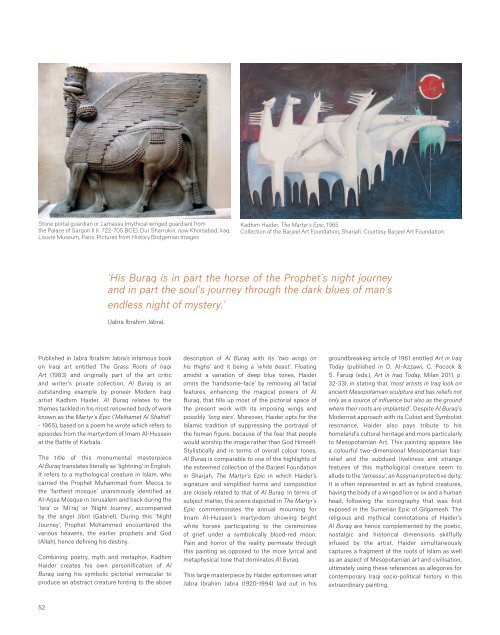NOW AND TEN
DUB1241_SaleCat
DUB1241_SaleCat
You also want an ePaper? Increase the reach of your titles
YUMPU automatically turns print PDFs into web optimized ePapers that Google loves.
Stone portal guardian or Lamassu (mythical winged guardian) from<br />
the Palace of Sargon II (r. 722-705 BCE), Dur Sharrukin, now Khorsabad, Iraq.<br />
Louvre Museum, Paris. Pictures from History Bridgeman Images<br />
Kadhim Haider, The Martyr’s Epic, 1965.<br />
Collection of the Barjeel Art Foundation, Sharjah. Courtesy Barjeel Art Foundation.<br />
‘His Buraq is in part the horse of the Prophet’s night journey<br />
and in part the soul’s journey through the dark blues of man’s<br />
endless night of mystery.’<br />
(Jabra Ibrahim Jabra).<br />
Published in Jabra Ibrahim Jabra’s infamous book<br />
on Iraqi art entitled The Grass Roots of Iraqi<br />
Art (1983) and originally part of the art critic<br />
and writer’s private collection, Al Buraq is an<br />
outstanding example by pioneer Modern Iraqi<br />
artist Kadhim Haider. Al Buraq relates to the<br />
themes tackled in his most renowned body of work<br />
known as the Martyr’s Epic (‘Melhamet Al Shahidi’<br />
- 1965), based on a poem he wrote which refers to<br />
episodes from the martyrdom of Imam Al-Hussein<br />
at the Battle of Karbala.<br />
The title of this monumental masterpiece<br />
Al Buraq translates literally as ‘lightning’ in English.<br />
It refers to a mythological creature in Islam, who<br />
carried the Prophet Muhammad from Mecca to<br />
the ‘farthest mosque’ unanimously identifed as<br />
Al-Aqsa Mosque in Jerusalem and back during the<br />
‘Isra’ or ‘Mi’raj’ or ‘Night Journey’, accompanied<br />
by the angel Jibril (Gabriel). During this ‘Night<br />
Journey’, Prophet Mohammed encountered the<br />
various heavens, the earlier prophets and God<br />
(Allah), hence defning his destiny.<br />
Combining poetry, myth and metaphor, Kadhim<br />
Haider creates his own personifcation of Al<br />
Buraq using his symbolic pictorial vernacular to<br />
produce an abstract creature hinting to the above<br />
description of Al Buraq with its ‘two wings on<br />
his thighs’ and it being a ‘white beast’. Floating<br />
amidst a variation of deep blue tones, Haider<br />
omits the ‘handsome-face’ by removing all facial<br />
features, enhancing the magical powers of Al<br />
Buraq, that flls up most of the pictorial space of<br />
the present work with its imposing wings and<br />
possibly ‘long ears’. Moreover, Haider opts for the<br />
Islamic tradition of suppressing the portrayal of<br />
the human fgure, because of the fear that people<br />
would worship the image rather than God Himself.<br />
Stylistically and in terms of overall colour tones,<br />
Al Buraq is comparable to one of the highlights of<br />
the esteemed collection of the Barjeel Foundation<br />
in Sharjah, The Martyr’s Epic in which Haider’s<br />
signature and simplifed forms and composition<br />
are closely related to that of Al Buraq. In terms of<br />
subject matter, the scene depicted in The Martyr’s<br />
Epic commemorates the annual mourning for<br />
Imam Al-Hussein’s martyrdom showing bright<br />
white horses participating to the ceremonies<br />
of grief under a symbolically blood-red moon.<br />
Pain and horror of the reality permeate through<br />
this painting as opposed to the more lyrical and<br />
metaphysical tone that dominates Al Buraq.<br />
This large masterpiece by Haider epitomises what<br />
Jabra Ibrahim Jabra (1920-1994) laid out in his<br />
groundbreaking article of 1961 entitled Art in Iraq<br />
Today (published in D. Al-Azzawi, C. Pocock &<br />
S. Faruqi (eds.), Art in Iraq Today, Milan 2011, p.<br />
32-33), in stating that ‘most artists in Iraq look on<br />
ancient Mesopotamian sculpture and bas reliefs not<br />
only as a source of infuence but also as the ground<br />
where their roots are implanted’. Despite Al Buraq’s<br />
Modernist approach with its Cubist and Symbolist<br />
resonance, Haider also pays tribute to his<br />
homeland’s cultural heritage and more particularly<br />
to Mesopotamian Art. This painting appears like<br />
a colourful two-dimensional Mesopotamian basrelief<br />
and the subdued liveliness and strange<br />
features of this mythological creature seem to<br />
allude to the ‘lamassu’, an Assyrian protective deity.<br />
It is often represented in art as hybrid creatures,<br />
having the body of a winged lion or ox and a human<br />
head, following the iconography that was frst<br />
exposed in the Sumerian Epic of Gilgamesh. The<br />
religious and mythical connotations of Haider’s<br />
Al Buraq are hence complemented by the poetic,<br />
nostalgic and historical dimensions skillfully<br />
infused by the artist. Haider simultaneously<br />
captures a fragment of the roots of Islam as well<br />
as an aspect of Mesopotamian art and civilisation,<br />
ultimately using these references as allegories for<br />
contemporary Iraqi socio-political history in this<br />
extraordinary painting.<br />
52


